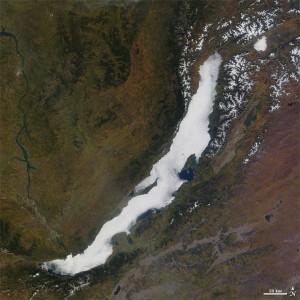NASA recently posted a satellite image of the world’s greatest lake painted with fog.

Lake Baikal, the oldest and deepest lake in the world, is shown covered with evaporation fog. Photo: NASA
The fog’s perfect outline of Lake Baikal in Siberia is a phenomenon known as evaporation fog. It happens when surface water evaporates into cold air and forms a cloud.
Lake Baikal isn’t the only great lake with fog events. The North American Great Lakes often experience lake effect, when warm, moist air blows off the lake and mixes with the cooler air over land to create fog and stratocumulus clouds. The Great Lakes get evaporation fog too.
How do these lakes size up from a world apart? At 25 million years old and with a depth of 5,600 feet (Lake Superior is only 1,330), Lake Baikal is the oldest, deepest lake in the world. It holds about 20 percent of the world’s unfrozen fresh water, two percent more than all five of the North American Great Lakes combined.
But it’s all in how you measure size. Lake Superior’s surface area of 31,700 square miles dwarfs Baikal’s mere 12,248.
Did I mention Lake Baikal is home to a monster?
Edited. Thanks Paul!
check superior’s depth